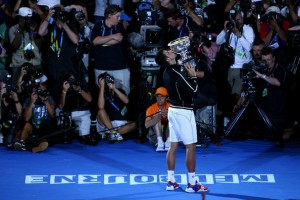“Is something unbelievable how he returns, no?” Rafa Nadal asked, rhetorically of course. He wasn’t looking for an answer and no one needed one.

It has been evident for more than a year now how Novak Djokovic’s return game has elevated from merely brilliant to unsurpassed magnificence.
We saw it when he shattered Roger Federer’s nerve in the semifinal of last year’s U.S. Open with an all-or-nothing slashing forehand to fend off a match point and we saw it again in the Australian Open final when, once again, he hammered a return — a backhand this time — that, if it wasn’t his most important shot of the day, was damn close.
It gave him the break that put him back on serve in the fifth set and, while there would be a few anxious moments before Nole could clutch the Australian Open trophy for his fifth major title, this return of serve was key.
It’s a 5-7, 6-4, 6-2, 6-7 (5), 7-5 win that will almost certainly find its way into the one-for-the-ages category and, while there is so much to be analyzed in this record five-hour and 53-minute odyssey, I find myself continuing to focus on Djokovic’s returns.
Of course the ground stroking is wonderful. Of course he has a superior serve. Of course he is no longer the physically fragile head case who rivaled Andy Murray for Grand Slam frustration. But for me, the major difference is the service returning.
Nadal is a great returner. Djokovic is incomparable.
“His return is probably one of the best in history. I never played against a player who returns like this,” Nadal told reporters in his post-match press session. ”
Novak seemed to have lost a half-step in the early stages of the final set of this championship match, and Nadal, who just continues to amaze you with his ability to fight off fatigue, was now up a break, serving at 4-2, but down 30-40 — a very critical stage.
Just as in the Federer match in New York, there would be no way that Djokovic would go into safe mode.
Nadal’s first serve was up the T, but intercepted by the top of the net. On second serve, he curled a beauty to the deep backhand corner. Not with great pace, but with great location.
Djokovic had set up just behind the baseline, stradding, in effect, what would be the extension of the singles sideline. Two steps to his left and now, with both feet outside the doubles sideline, he rammed a risky deep return that came down either right on or a hair in front of Nadal’s baseline.
Rafa, who had stepped into the court on his service follow-through, had to quickly retreat and had only one play — a forehand half-volley at the baseline. It was an extremely difficult position for him and he hit long. It was, by any statistician’s judgment, a forced error.
The Djokovic return strikes again.
Let me throw some numbers at you. You don’t really need them to authenticate Djokovic’s great returning, which requires only a pair of eyes. But they’re interesting, nevertheless.
Nole played 231 total games in seven Aussie Open matches, plus three tiebreaks, and he won 46 percent of his return games. Put another way, 2.1 service breaks per set.
Djokovic was aced just 27 times in seven matches, and 19 of those came against Andy Murray in the semis and Nadal. Put another way, together Nadal (10 aces) and Murray combined to ace Djokovic just once every 2.7 service games. He also was aced three times by Santiago Giraldo in the second round, three times by Lleyton Hewitt in the fourth round, twice by David Ferrer in the quarters and had a clean sheet against both Paolo Lorenzi and Nicolas Mahut, the man who crashed 103 aces in the multi-day marathon at Wimbledon against John Isner.
Mahut was hurt for this third-round match against Djokovic and there can be no doubt he was way below his best fitness, but he was on court. He played the match, and you don’t have to run to hit serves.
One final set of numbers. Djokovic generated 109 break-point opportunities with his returning and converted 54 of them for 49.5%. That’s way over the tour-wide average and as good as Xavier Malisse’s leading 49% of 2011.
Moreover, Djokovic had 46 break-point opportunities in the five-setters with Murray and Nadal and converted 18 — a 39.1% conversion rate.
I doubt many are going to want to replay a tape of this near-five hour match, but if you take any time to look at even parts of this magnificent match, I want you to just concentrate on Djokovic’s returns. Watch the feet, watch the aggressiveness, watch the rapid preparation. You’ll be watching the best returner in tennis and maybe the best to ever play the game.
Charles Bricker can be reached at nflwriterr@aol.com
